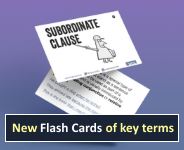Glossary: declarative clause
Explanation
The most common clause type, which usually has regular grammatical ordering with the Subject before the finite verb, followed by the Object (if there is one), and which is usually, though not exclusively, used to make a statement. See also: exclamative clause, imperative clause, interrogative clause.Englicious contains many resources for English language in schools, but the vast majority of them require you to register and log in first. For more information, see What is Englicious?

